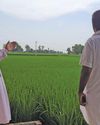As early as in 1880, Charles Darwin demonstrated that plants could sense light, moisture, gravity, pressure and possessed several other qualities. Over the years, many scientists have proved that plants are sentient beings and move and respond to sensation. The subject is still controversial among the scientific community. Monica Gagliano is research associate professor of evolutionary ecology and former fellow of the Australian Research Council who has pioneered a brand-new research field of plant bioacoustics. In her latest book, Thus Spoke the Plant: A Remarkable Journey of Groundbreaking Scientific Discoveries and Personal Encounters with Plants, she, for the first time, has experimentally demonstrated that plants emit their own ªvoicesº and detect and respond to the sounds of their environments. In these excerpts, Gagliano writes about how the pea plant responds to acoustic vibrations to locate water

Oryngham means thank you for listening in the language of the plants. It is not a word, as we humans understand it, because its meaning cannot be spoken—nor can it be heard. However, we can experience it by feeling with our bodies and listening to what our ears cannot hear. When we learn to listen to plants without the need to hear them speak, a language that we have forgotten emerges; it is a language beyond words, one that does not wander or pretend or mislead. It is a language that conveys its rich and meaningful expression by bypassing the household of our mind and directly connecting one spirit to another. This language belongs to plants, and so do these stories.
IN GENERAL, organisms use various kinds of information transmitted by smells, sounds, lights, or magnetic fields in order to make good choices and avoid fatal errors. Based on this idea and as instructed by Ayahuma, I designed the experiments with the peas in the maze to test how roots choose the direction that correctly leads them to water, depending on the cues available. Particularly, could the roots of the young peas sense the acoustic vibrations generated by water moving underground or inside pipes? Could they use the sound of water alone to detect and find its source, when no actual water was available in close vicinity?
To answer this, I wrapped a sealed, soft plastic pipe through which water was constantly flowing around the base of one side of the maze, but the water itself was never directly accessible to the plants. Then I compared the choices roots made in these mazes to those they made growing in mazes where the soil was kept moist by actual water contained in the small plastic tray attached at the base of one side of the maze, hence producing a moisture gradient.
Denne historien er fra January 01, 2019-utgaven av Down To Earth.
Start din 7-dagers gratis prøveperiode på Magzter GOLD for å få tilgang til tusenvis av utvalgte premiumhistorier og 9000+ magasiner og aviser.
Allerede abonnent ? Logg på
Denne historien er fra January 01, 2019-utgaven av Down To Earth.
Start din 7-dagers gratis prøveperiode på Magzter GOLD for å få tilgang til tusenvis av utvalgte premiumhistorier og 9000+ magasiner og aviser.
Allerede abonnent? Logg på

A SPRIG TO CARE FOR
Punarnava, a perennial herb, is easy to grow and has huge health benefits

DIGGING A DISASTER
Soapstone mining near Dabti Vijaypur village has caused many residents to migrate.

REVIEW THE TREATMENT
Several faecal sludge treatment plants in Uttar Pradesh suffer from design flaws that make the treatment process both expensive and inefficient

MAKE STEEL SUSTAINABLE
As India works to double its GDP by 2030, its steel industry must balance growth with sustainability. By embracing policies like the Steel Scrap Recycling Policy 2019 and adopting green technologies, India is paving the way for a more sustainable future in steel production

Can ANRF pull off the impossible for India?
Anusandhan National Research Foundation is expected to reorient India's innovation goals but funding issues, old mindsets remain a drag

TROUBLED WOODS
Forests are a great bulwark against climate change. But this is fast changing. AKSHIT SANGOMLA travels through some of the pristine patches of the Western Ghats to explore how natural disturbances triggered by global warming now threaten the forest health

BLINDING GLOW
The science is clear: increased illumination has damaging consequences for the health of humans, animals and plants. It’s time governments introduced policies to protect the natural darkness and improved the quality of outdoor lighting.

GROUND REALITY
What happens when the soil loses the ability to grow healthy, high-yield crops on its own?

GM POLICY MUST BE FARMER CENTRIC
On July 23, the Supreme Court of India directed the Union government to develop a national policy on genetically modified (GM) crops for research, cultivation, trade and commerce through public consultation.

Vinchurni's Gandhi
A 96-year-old farmer transforms barren land into a thriving forest in drought-prone region of Satara